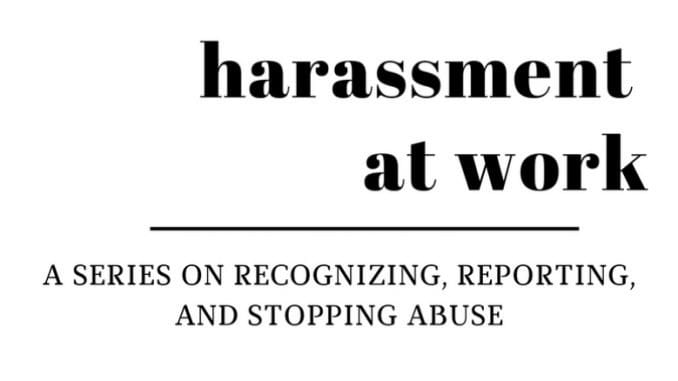
Harassment at work is real, but what do you do when it happens to you? How do you know when someone’s behavior has crossed the line? And who do you tell? In this eight-part series, we break down what harassment is and what to do about it.
BY ASHLEY RODRIGUEZ
BARISTA MAGAZINE ONLINE
Note: This series will explore issues of harassment and recount episodes of alleged harassment in the workplace. If you are sensitive to stories and scenarios depicting workplace harassment, please be advised.
This series is an accompaniment to the February + March 2018 article, “Coexisting at Work: Sexual Harassment Policies,” written by Lauren Lathrop. It’s meant to define sexual harassment and provide a blueprint as to how to handle workplace harassment. The first part of this series defined harassment, while part two talked about legal protections and laws defining sexual harassment. Here in part three, we’ll talk about documenting harassment and why it’s important to write everything down.
For all the protections outlined by the Equal Employment Opportunity Commission (EEOC) and laws in place regarding sexual harassment, proving that you’ve been harassed is difficult. Not only is the onus on the victim of harassment to prove that harassment is happening, but it’s their job to show that they tried reporting abuse to their bosses and management ignored those concerns—remember in part two we discussed how employers are required not to prevent harassment, but to stop it once they are made aware of it. While we don’t agree with the burden put on victims of abuse to prove that abuse is happening, it’s important to understand what proof looks like and how to demonstrate that abuse has happened.
LOG EVERY INCIDENT
Proof doesn’t have to be a video or a recording—if you have been harassed at work, make sure to write it down. Log what happened, what time it happened, who said or did the harassing behavior, who witnessed it, and how it interfered with your ability to do your job. As Kat Melheim mentions on the website coffeepeople.org and their tips on how to deal with sexual harassment, “If you can, note what you did to express that the harasser’s behavior was ‘unwelcome.’” (In order for the sexual harassment to be considered illegal, you/your counsel must show that the conduct was “unwelcome.”) If you can’t remember exactly what happened or what was said, try to get the gist of things and record how the incident made you feel.
REFER TO YOUR EMPLOYEE HANDBOOK
Not all employers are required to have a harassment policy, but some do, and they could outline how to log and report harassment—perhaps through an incident report or outlining the appropriate chain of command. If you’re a supervisor and your employee is a victim of harassment or you witness someone else being harassed, the handbook may help you figure out who to report to and the necessary actions you should take.
REQUEST NOTES FROM EVERY MEETING
If you do sit down with your employer or HR manager, make sure that someone is taking notes during the meeting. One of the biggest problems I hear from people who have reported harassment but were ignored is that they had a verbal meeting with their superiors, but there are no notes or documents showing that the meeting happened or that harassment was discussed. If you do meet with a manager or supervisor, make sure you or someone there is taking notes, and make sure to request a copy. If you sign anything, make a copy. If no one takes notes, send a follow-up email detailing the meeting and what you talked about. If you can, use audio to record the meeting—depending on the state, you can record meetings as long as one of the parties recording consents, so if you verbally consent, that’s enough to hit the record button. However, this depends state-by-state.
BRING IN PEOPLE
If you have to report an incident to a manager you don’t think will be responsive, it can be helpful to have someone else there with you. If someone else witnessed the behavior, ask them to sit in the meeting with you. If you have to first report an incident to your immediate supervisor, ask a colleague or a member of a different department to sit in. You might not trust the person you’re required to report to, so having a third party can help ensure clarity and remove any element of confusion as to what was said in the meeting.
SAVE EVERY EMAIL, TEXT, OR DOCUMENT
We live in an era where we can easily save receipts—a quick snapshot saves a text or an email, so make sure you save any communications between coworkers that demonstrate you’ve been harassed. Equally important is to save any email that shows you attempted to let someone know about the harassment. As we mentioned before, it’s an employer’s responsibility to stop harassment, and an employer may be able to escape this responsibility by denying that they knew anything about the harassment.
If you choose to file a complaint with the EEOC or a lawsuit with a lawyer, the first thing they’ll ask for is documentation because it is one of the ways to prove that harassment happened. In the next edition of our series, we’ll talk about why proof is important.
Disclaimer: This article is meant to be informative and provide guidance. This is not meant to be legal advice. This publication is read by a variety of people all over the world, and laws regarding workplace harassment can vary wildly. If you are thinking about filing a workplace harassment lawsuit, please consult a licensed attorney in your state or jurisdiction.

